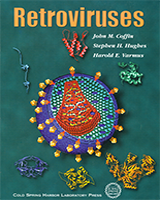NCBI Bookshelf. A service of the National Library of Medicine, National Institutes of Health.
Coffin JM, Hughes SH, Varmus HE, editors. Retroviruses. Cold Spring Harbor (NY): Cold Spring Harbor Laboratory Press; 1997.
Physical Gene Transfer Methods
Physical gene transfer techniques include the transfer of naked DNA by microinjection into cells or by direct infusion into tissues, transfer of CaPO4-DNA precipitates, liposome-DNA complexes, or DNA-polylysine complexes, and bombardment with DNA bound to particle carriers. In contrast to viral gene transfer vectors, these vectors can be easily produced in pure form, any sequence can be transferred without a significant limit on size or compatibility with viral replication, and there is no issue of helper virus contamination. However, none of these techniques provides for specific integration, and DNA that does integrate is often inserted in tandem arrays with rearrangements. It may eventually be possible to develop a homologous (or some specific nonhomologous) recombination system that will circumvent these problems; at the moment, the efficiency of such systems is lower than that of viral vectors, which is an important consideration for applications such as gene therapy where efficiency is critical. It is possible to incorporate sequence elements that allow episomal maintenance of plasmids in transfected cells, although this technique currently depends on viral proteins, such as SV40 or polyomavirus T antigens, for the maintenance of the episomes. It may be possible to design artificial chromosomes that would bypass the need for integration and allow the transfer of very large DNA units. For now, the efficiency of DNA-mediated gene transfer depends on the technique employed and the target cell type, but it is always much lower than the efficiency of virus-mediated gene transfer.
Viral Gene Transfer Methods
The viral vectors that are being used for gene transfer studies in cultured cells and animals are summarized in Table 3. Retroviral, adenoviral, and adeno-associated viral vectors have also been used in human trials. As this field expands, additional viruses will certainly be developed as vectors for gene transfer.
Table 3
Properties of Viruses Used to Derive Gene Transfer Vectors.
Adenovirus
Adenovirus is a double-stranded DNA virus that does not go through an RNA intermediate, and thus inserted sequences need not be compatible with transcription of the complete viral genome and its subsequent reverse transcription as for retroviral vectors. With a genome size of 36 kb, there is considerable room for additional DNA in adenoviral vectors. Adenovirus is a lytic virus that does not normally integrate its genome into the host chromosome, so gene transfer by adenoviral vectors is, in general, temporary. Current adenoviral vectors are constructed by replacement of some of the segments of the virus that are expressed early in the life cycle of the viral sequences of interest. To produce adenoviral vectors, vector DNA is transfected into a cell line that expresses products of the early genes that were deleted from the vector. Vector titers can be very high, up to 1012 transducing units per milliliter. Because the expression of adenoviral genes is under complex control, and the fact that adenovirus is cytotoxic, packaging cell lines that produce all of the proteins required for adenoviral replication will be difficult to construct. Following transduction of cells, current adenoviral vectors synthesize low levels of adenoviral proteins from coding regions remaining in the vectors. This poses a particular problem for any application of these vectors to therapy. Adenoviral vectors that induce the expression of any viral genes in humans trigger an immune response that results in killing of the adenovirus-infected cells and prevents further in vivo treatments with the vector. Despite these problems, several groups are currently testing adenoviral vectors for treatment of cystic fibrosis.
Adeno-associated Virus
Adeno-associated virus (AAV) is a small, single-stranded DNA virus that can integrate into the genome of infected cells. Although the wild-type virus integrates preferentially in a specific region of human chromosome 19, vectors derived from AAV appear to integrate randomly in genomic DNA (Russell et al. 1994). The amount of DNA that can be carried by AAV vectors is limited to about 4.5 kb, exclusive of the signals needed in cis for viral replication. Effective titers of AAV vectors are similar to those of retroviral vectors (∼107/ml). AAV vectors are being explored for delivery of genes to the airway for treatment of cystic fibrosis (Flotte et al. 1993), to the brain (Kaplitt et al. 1994), and to hematopoietic cells (Miller et al. 1994).
Herpes Simplex Virus
Herpes simplex virus (HSV) is being considered as a vector for neural cells where the virus can establish a latent infection. HSV has a large DNA genome that does not replicate via an RNA intermediate. The large viral genome provides a space for large amounts of inserted DNA. However, the complexity and large size of HSV present problems for the design of vectors and potential packaging cells. The primary interest in developing HSV vectors for gene therapy is for the transfer of genes to neural tissues (e.g., the brain, spinal cord, and peripheral nervous system).
- Comparison to Other Gene Transfer Systems - RetrovirusesComparison to Other Gene Transfer Systems - Retroviruses
Your browsing activity is empty.
Activity recording is turned off.
See more...
